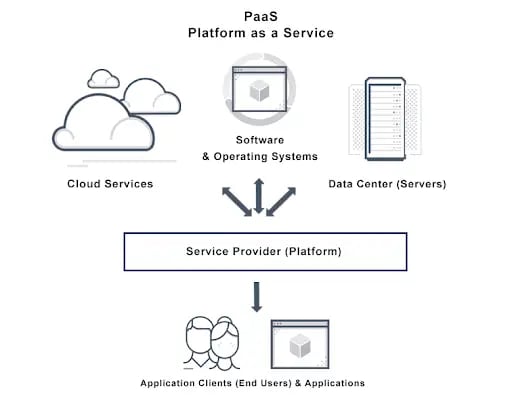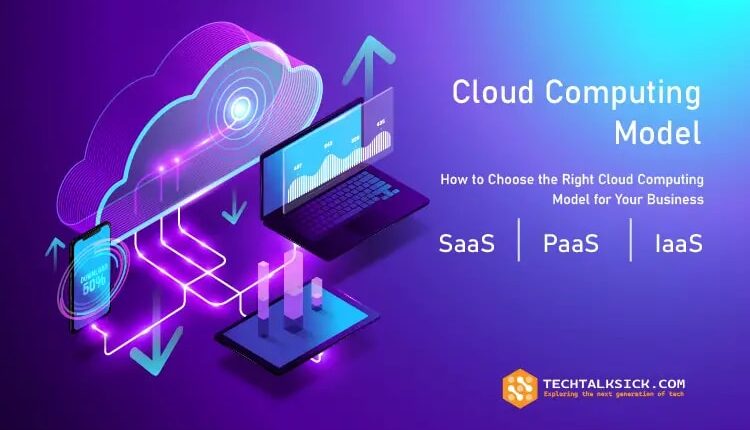Cloud Computing Models
Cloud computing is a broad term for the delivery of hosted services over the internet. These services can include anything from software applications to data storage to computing power.
There are three main types of cloud computing models:

Software as a Service(SaaS):
SaaS is a cloud computing model in which software applications are hosted and managed by a third-party vendor and delivered to users over the Internet. SaaS applications are typically subscription-based, and users can access them from any device with an internet connection.
SaaS is a good choice for businesses that need to use software applications but don’t want to worry about managing the underlying infrastructure. SaaS applications are typically very reliable and secure, and they can be a cost-effective way to get the software you need.
Examples of SaaS applications include Salesforce, Google Apps, and Microsoft Office 365.

Platform as a Service (PaaS):
PaaS is a cloud computing model in which a third-party vendor provides a development environment that includes tools, infrastructure, and services that developers can use to build, test, and deploy applications. PaaS platforms typically include features such as a code editor, a debugger, a testing framework, and a deployment engine.
PaaS is a good choice for businesses that want to develop and deploy applications quickly and easily. PaaS platforms can help businesses to save time and money, and they can also help to improve the quality of their applications.
Examples of PaaS platforms include Heroku, Amazon Web Services Elastic Beanstalk, and Google App Engine.

Infrastructure as a Service (IaaS):
IaaS is a cloud computing model in which a third-party vendor provides access to computing resources, such as virtual machines, storage, and networking. IaaS customers can use these resources to build and deploy custom applications or to host existing applications.
IaaS is a good choice for businesses that need to have complete control over their infrastructure. IaaS can help businesses to save money on hardware and software, and it can also help to improve the flexibility and scalability of their IT environment.
Examples of IaaS providers include Amazon Web Services EC2, Microsoft Azure Virtual Machines, and Google Compute Engine.
Choosing the Right Cloud Computing Model
The right cloud computing model for your business will depend on your specific needs and requirements. Here are some factors you should consider when choosing a cloud computing model:
- Your business needs: What types of applications do you need to run? How much data do you need to store? How many users will be accessing your applications?
- Your budget: How much are you willing to spend on cloud computing?
- Your security requirements: How important is security to your business?
Once you have considered these factors, you can start to narrow down your choices. If you need help choosing a cloud computing model, you can consult with a cloud computing expert.
In addition to these three main models, there are a number of other cloud computing models that are emerging, such as:
Data as a Service(DaaS):
DaaS provides access to data that is stored and managed by a third-party vendor. This data can be used for a variety of purposes, such as analytics, business intelligence, and machine learning.
Examples of DaaS providers include Amazon Redshift, Google BigQuery, and Microsoft Azure Data Lake Storage.
Function as a Service(FaaS):
FaaS provides a way to run code without having to worry about managing servers or infrastructure. This makes it a good choice for developers who want to focus on building applications without having to worry about the underlying infrastructure.
Examples of FaaS providers include AWS Lambda, Google Cloud Functions, and Azure Functions.
Backend as a Service(Baas): Baas provides a backend infrastructure for mobile and web applications. This includes services such as user management, authentication, and push notifications.
Examples of Baas providers include Firebase, Parse, and AppCloud.
Communication as a Service(UCaaS): UCaaS provides unified communications services, such as voice, video, and messaging, over the Internet. This can help businesses to save money and improve communication with their employees and customers.
Examples of UCaaS providers include Microsoft Teams, Zoom, and Google Hangouts Meet.
Each cloud computing model has its own advantages and disadvantages.SaaS is a good choice for businesses that need to use software applications but don’t want to worry about managing the underlying infrastructure. PaaS is a good choice for businesses that want to develop and deploy applications quickly and easily. IaaS is a good choice for businesses that need to have complete control over their infrastructure.
Benefits of Cloud Computing
There are many benefits to using cloud computing, including:
- Cost savings: Cloud computing can help businesses to save money on hardware, software, and IT staff.
- Scalability: Cloud computing is scalable, so businesses can easily add or remove resources as needed.
- Agility: Cloud computing can help businesses to be more agile and responsive to changing market conditions.
- Security: Cloud computing providers offer a high level of security, which can help businesses to protect their data.
- Compliance: Cloud computing providers can help businesses to comply with industry regulations.
Conclusion
Cloud computing is a powerful tool that can help businesses to save money, improve agility, and increase security. If you are considering using cloud computing, it is important to choose the right model for your needs.
#Choose #Cloud #Computing #Model #Business


